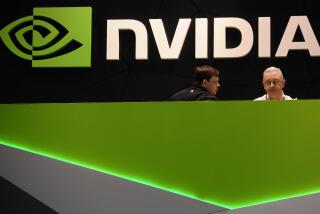Synergy of Contrasting Personalities Behind Chip Merger
It was April 7, and W. J. “Jerry” Sanders and Irwin Federman, two of Silicon Valley’s most easily recognized executives, were doing a deal at the Chantilly, a Palo Alto restaurant where the hushed buzz of serious high-tech conversation is mellowed by $250 bottles of ruby red wine and blush pink decor.
When dinner was over and their deal nearly done, Sanders paid the bill. “When I’m with Jerry, he picks up the tab,” Federman recounted. “I figure, the guy who goes around in a Rolls-Royce and carries on his person, in clothes, jewelry and accouterments, more than my house is worth, well, he pays the bills.”
Sanders returned to the Chantilly for dinner last Thursday, the day the $422-million merger of his company, Advanced Micro Devices, and Federman’s Monolithic Memories Inc. was announced.
This time, the buzz was all about Sanders and Federman, AMD and MMI.
Who in the Valley, the technophiles’ mecca, could resist the subject? The merger of two like-minded companies, each headed by a character of grand proportions: Sanders, whose picture ought to be in the dictionary as a definition for “flamboyant”--the guy about whom every techie has a favorite outrageous story. And Federman, the self-described bean-counter who ranks as a major force in the complex technological world of semiconductors--and, some say, as the best storyteller in the Valley.
But the AMD-MMI story is more than just fodder for glib gossip. In the past, such deal making has spawned new technologies and new companies that changed the way the world does business. And those who listen closely to the Valley grapevine are measuring the Sanders-Federman deal in just those terms.
The marriage of AMD and MMI is a portent of change in the U.S. semiconductor industry. Change that, industry experts believe, could help ensure the survival of the domestic industry--deemed vital to national security and technological leadership--in the face of further Japanese penetration of the $30-billion worldwide market.
The American chip industry has looked for government aid and resolution of the trade dispute with Japan to help it regain worldwide competitiveness. But progress there has been slow; during their summit last week, President Reagan and Japanese Prime Minister Yasuhiro Nakasone couldn’t reach agreement on major trade issues, including U.S. tariffs stemming from an unfulfilled chip-trade agreement.
Federman, chairman of the industry’s trade group, and Sanders have been active in the call for help from Washington, but they have also looked inward.
“This is a concentration of force that will make us stronger in the worldwide market,” said Sanders. “We’re the first, but we won’t be the last to merge. . . . There’s going to be an oligopoly of big players, with perhaps a scattering of small companies. But this concept of a panoply of players is impossible.”
Sanders is given to using superlatives, especially in the context of his own accomplishments. But this time, he isn’t alone in his assessment of the situation. Many industry executives and analysts believe the AMD-MMI merger signals a major consolidation in the U.S. chip industry, even as signs of a cyclical upturn grow stronger.
(The consolidation may reach out to the global market: The day before the Silicon Valley deal was announced, two European companies, Thomson of France and Italy’s telecommunications company, STET, said they would merge their semiconductor operations.)
On Friday, speaking from the mobile phone in his white Rolls-Royce, Sanders recounted the events that led to the merger.
At the end of last year, he said, AMD’s steering committee met to evaluate the company’s options, including acquisitions.
“We decided certain companies would make a good fit with AMD, and MMI was at the very top of the list,” Sanders said. “I approached Irwin (Federman) and said ‘wouldn’t we be stronger together?’ ”
The fit, analysts believe, is better than good. AMD has plenty of manufacturing capacity but has relied heavily on other companies’ technologies. MMI has top-rated products that hold almost 50% of a roughly $500 million market niche that continues to grow, but is running out of room at its plants.
Combined sales of the companies could total $1 billion this year--a mark Sanders long ago set his heart on.
He nearly achieved it alone. In March, 1985, AMD closed its fiscal year fat from the boom in chip-laden personal computers. The company had invested nearly $500 million in plants and equipment during a 36-month period, rivaling the massive Japanese semiconductor industry investment. AMD was nearly a “giga-buck” company--Sanders’ term for $1 billion in sales.
But then, the buildup of plant capacity on both sides of the Pacific was answered by a plunge in demand for semiconductor companies’ products. Chip prices thudded, scraping away American chip makers’ profits. Shiny new $100-million plants stood hollow. Between 30,000 and 40,000 U.S. chip workers lost their jobs--500 at AMD last year, when it could hold out no longer and abandoned its nearly sacred no-layoff policy. In fiscal 1986, AMD ran up losses of $95.8 million.
Sanders, the company chief executive who had raffled off houses and cars to employees and staged $1-million company parties, was “shocked” by the recession, said one industry insider. “I don’t think he could believe it when it happened. He got a good dose of reality.”
Said one industry analyst: “Some of that ego had to be sublimated or repressed, and then he got about the business of making good business decisions based on reality.”
Federman said his new partner still “lives splendidly,” but the recession cut into even Sanders’ high-flying life style. He keeps a co-op apartment in San Francisco’s Russian Hill district, a beach house in Malibu and a mansion in Bel Air. But last year, there was no big Christmas party, and his stable of expensive cars has been winnowed down to three.
Once he was asked why he kept a black Rolls-Royce in Northern California and a white one in the southern part of the state. His response: “So I can tell where I am in California.”
The black Rolls is gone, he said Friday.
“I’m down to three cars now--my white Rolls here, and a white Rolls Corniche and a black Bentley Corniche in Los Angeles.” And, in a deadpan, he added: “We had a recession, you know.”
White is a Sanders trademark. Usually exquisitely dressed--often in white--51-year-old Sanders is a head turner, his blue eyes framed by the milk-white of his hair and mustache. Tall and slim, he moves through a crowd with a litheness that bespeaks his full measure of confidence.
Federman is also 51, and tall and slim. “But I look older,” said Federman. “He has hair, and I’ll take it in any color. And I worry a lot and have wrinkles.”
The MMI chief executive calls himself a “stick in the mud” compared to Sanders. “Jerry is entitled to his plumage,” he said. “We all have some, but Jerry just has a lot more of it.”
On the day the AMD-MMI deal was announced, Sanders was speaking at a large technology conference in San Francisco. One reporter noted that he was decked in diamond rings, a jeweled Rolex watch and shod in green alligator-leather shoes.
“Yes, I was,” Sanders laughed Friday. “The shoes were dark green,” he said, pausing for effect before he added: “the color of money.”
“But,” he said, “the flash and flamboyance are the form and not the substance of Jerry Sanders.”
Federman agrees. “Underneath his plumage, there are sound values and vision . . . . I don’t think the Jerry Sanders one sees in public is any more revealing of the inner man than it would be of any one else.”
Federman’s business insights at first astounded his co-workers, said one MMI executive. Unlike Sanders, who had learned chip technology while a salesman at Fairchild Semiconductor and then created AMD in his own image, Federman does not have a technical background. He worked up through the financial side of the business to the rank of president eight years ago. Since then, he has gained a wide knowledge of the technology, primarily by asking questions others were afraid to ask and making engineers explain themselves, said company insiders.
“His strongest skills are people skills and leadership qualities,” said Tim Propeck, vice president of marketing at MMI. “He was chief financial officer of the company for a number of years, and when he became president, people were shocked by his interpersonal skills. Those are, well, not common among bean-counters.”
Now, say observers, MMI bears Federman’s stamp, just as AMD bears Sanders’. “He has imprinted his personality on the company,” said Propeck. “He said he felt his primary job as chief executive was to enhance people’s sense of their own self-worth.”
Even now, Federman is concerned about the “extraordinarily difficult” process of putting the two companies together. For the first year or so after the merger takes effect in September, MMI will be operated as a subsidiary of AMD. Integration of the companies and their staffs will follow.
“It will be terribly hard,” said Federman, “but if we didn’t have the synergy between Jerry and me, it would be impossible.”
Although Sanders said a no-layoff policy is no longer workable in the changed competitive climate of the semiconductor industry, Federman is hopeful that the task can be accomplished with few layoffs.
Valley pundits are already wondering if Federman, who will become vice chairman of the merged company, will be one to go.
“Irwin doesn’t have a big ego, but Jerry’s is as big as all outdoors,” said a former AMD employee. “Jerry doesn’t subordinate his ego to anybody.”
One analyst agreed, predicting that Federman would leave the company once the absorption of MMI was complete. “Sanders will not be sharing his control with anybody. Irwin would be secondary, and he’s got better things to do. He’s recognized as one of the brightest executives in the business, and he’ll have lots of opportunities to do something else.”
But Federman professes no qualms about the setup.
“I am not worried about being overshadowed by Jerry,” he said. “He’ll definitely be chief executive and chairman. He has a certain style, and I wouldn’t try to compete. But how we work together in a corporate environment is going to require, under certain circumstances, that each of us subordinate our egos.”






